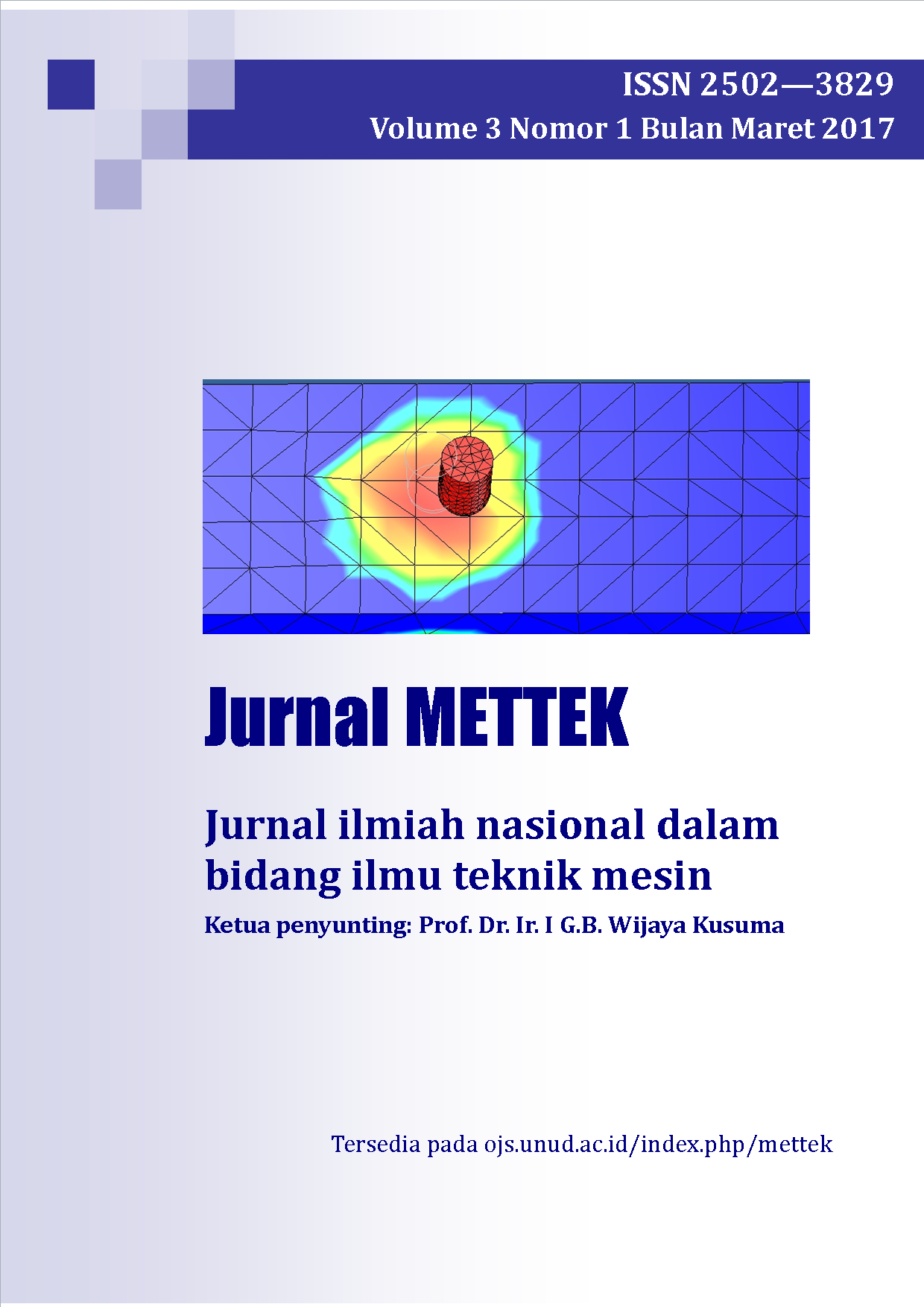PENGARUH KOMPOSISI BIOMASSA DAN BATUBARA TERHADAP PERFORMANSI CO-GASIFIKASI SIRKULASI FLUIDIZED BED
Abstract
Teknologi co-gasifikasi circulating fluidized bed adalah pengkonversian dua campuran bahan bakar padat terfluidakan secara thermokimia menjadi bahan bakar gas mudah terbakar. Proses ini memerlukan sekitar 50% udara pembakaran. Batubara adalah sumber energi fosil yang paling siap untuk menggantikan peran minyak bumi sedangkan serbuk kayu adalah biomassa yang dapat digunakan sebagai sumber energi ramah lingkungan. Reaktor Gasifier circulating Fluidized Bed yang digunakan untuk penelitian berdiameter 96cm dengan tinggi 162cm dan ketebalan 3 mm dengan bahan plat stainless steel sc 20. Komposisi campuran bahan bakar yang digunakan adalah 30% batu bara: 70% serbuk kayu dengan membandingkan hasil tanpa system circulating fluidized bed. Temperatur operasi dalam penelitian ini adalah 600 0C. Hasil dari pengujian, didapat kan kandungan CO tertinggi dihasilkan pada system circulating fluidized bed sebesar 20,99%. Hal ini disebabkan karena komposisi bahan bakar serbuk kayu yang lebih banyak dari batubara. Persentase kandungan CO2 yang paling rendah terdapat pada variasi komposisi campuran bahan bakar 30% batubara dan 70% serbuk kayu. Dari data hasil perbandingan co-gasifikasi dengan system fluidized bed dengan co-gasifikasi yang dilengkapi dengan recirculating pluidized bed, ternyata pada co-gasifikasi dengan system sirkulaasi fluidized bed kandungan gas CO yang didapatkan prosentasenya lebih tinggi.
Co-gasification circulating fluidized bed technology is the conversion process of two mixed solid fuel into combustible gas thermochemical. This process requires about 50% of air combustion. Coal is the most effective fossil energy source to replace petroleum, while saw dust is a biomass that can be used as an eco-energy source. Circulating Fluidized Bed Gasifier reactor used for the research had 96cm diameter with162cm height and 3 mm thickness with 20 sc stainless steel plate. The fuel mixture composition 30% coal: 70 % saw dust. By comparing the gas and temperature result without circulating system versus with circulating fluidized bed. The temperature of this study was 600 C. The results of the test, obtained the highest content of CO gas produced by composition of 30% coal and 70% saw dust, it was 20,99%. This was because the saw dust fuel composition was more than coal composition. The percentage of the lowest CO2 contained in the fuel composition of 30% coal and 70% saw dust. Based on the comparison result of co-gasification without circulating fluidized bed and with circulation fluidized bed, the circulation fluidized bed more efficient then co-gasification without circulating fluidized bed. The CO gas percentage demand output from co-gasification circulating fluidized bed is higher.
Downloads
References
[2] Prabir Basu,Scott A.Fraser”Circulating Fluidzed Bed Boiler”design and operation li-brary cataloging-in-publication Data,1946.
[3] United Nations Environment Programme. 2006. Pedoman Efisiensi Energi untuk In-dustri di Asia.
[4] Norwick, L., Bedyk, T., Stolarek, P., Ledakowicz, S. (2008). Fluidized Bed Gasifica-tion to Convert Waste in to Syngas.
[5] Winaya Suprapta, I N., Sucipta, I M., dan Susila I D M. 2011.“Pengaruh Temperatur Operasi dan Kecepatan Superficial Terhadap Komposisi Gas Produser pada Gasifi-kasi.
[6] Fluidized Bed Berbahan Bakar Sampah Terapung”. Jurnal Ilmiah Teknik Mesin CakraM, vol. 5, No. 1, April 2011, hlm. 85-90.
[7] Yusgiantoro,P.(2006)”Energy Strategy Of Indonesia”. Proceedings The international Energy conference 6th CoalTech,Bali 4-5,P.4.

This work is licensed under a Creative Commons Attribution-NonCommercial-ShareAlike 4.0 International License.







